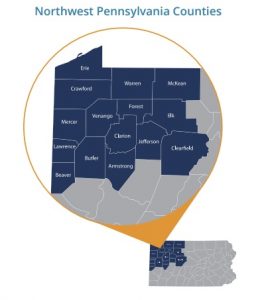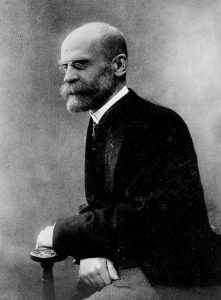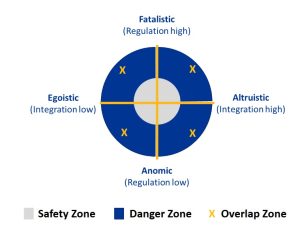The Social Roots of Suicide

The Northwest Pennsylvania (NW PA) Veteran Suicide Prevention Program operates on a three-pronged approach involving healthcare providers, community organizations, and Veterans and their families in the 15 counties of NW PA.
This article summarizes a recent research presentation by Patti Tanner, Senior Program Implementation Specialist, and explores the following topics:
- Durkheim’s Theory of Suicide
- Integration and cultural regulation of social relationships
- Advances in research
Read time: 7 minutes
A pdf of the presentation is available for download.
Durkheim’s Theory of Suicide
 Emile Durkheim (1858-1917), was a 19th century sociologist who studied suicide at the macro- or societal-level with a focus on structural insights. He believed behavior is caused by social facts, which are social forces that surround society and act upon individuals. Today, social patterns found in suicide data analysis demonstrate that suicide is not a random individual act. This finding supports Durkheim’s theory that suicide is a social fact.
Emile Durkheim (1858-1917), was a 19th century sociologist who studied suicide at the macro- or societal-level with a focus on structural insights. He believed behavior is caused by social facts, which are social forces that surround society and act upon individuals. Today, social patterns found in suicide data analysis demonstrate that suicide is not a random individual act. This finding supports Durkheim’s theory that suicide is a social fact.
Durkheim Established Two Core Principles:
1. That the structure of social relationships shapes the structure of suicide
2. That social relationships vary according to their level of:
• Integration concerns the quantity and quality of social ties. Integration refers to the extent to which an individual is bound to the moral demands and social relations of a group. In this regard, collective belonging can protect individuals from suicide by providing them with social capital
• Cultural Regulation involves how culture shapes and regulates individuals and includes the normative or moral demands placed on the individual that come with membership in a group.
Within a collective, ways of acting and thinking reinforce integration and provide individual members a sense of who they are, what they are supposed to feel, think, and do under various conditions, and what it means to belong to that group.
The Four Social Environments 
Durkheim identified four social environments and how social relationships are constructed.
Anomic: a social environment in which there is a dizzying amount of social change and lack of social regulation.
Altruistic: a social environment in which the group takes precedence over the individual; sacrifice of individual life in order to fulfill some obligation for collective benefit or a group cause.
Fatalistic: a social environment in which there is little to no change in role expectations and individuals are confronted with total social stagnation.
Egoistic: a social environment in which there is profound social isolation or a prolonged sense of not belonging/not being integrated in a community (loneliness or excessive individuation).
In looking at the sociology of suicide it is necessary to consider the four social environments.
• Focus on the socioemotional structure that underlies both the protective and harmful sides of human interactions.
• Consider how cultures/structures play a major role in shaping an individual’s cognition, meaning-making, decision-making, and action.
• The change agent is altering a social environment, not the person.
How Durkheim’s Theory is Relevant Today
 Recent theories of suicidology integrate perceptions about group belongingness and connectedness. In addition, current research also explores and validates the importance of:
Recent theories of suicidology integrate perceptions about group belongingness and connectedness. In addition, current research also explores and validates the importance of:
• Identities, and the emotional attachment we have to our identities.
• Emotions as signals of success or failure that become internalized into psychological well-being or pain.
• The social network perspective which demonstrates that the presence of negative and positive ties.
• Cultural meaning and how people are motivated to act by the cultural schema, scripts, and frames they are exposed to, internalize, and take for granted.
Share Our Vision and Get Involved
Our Vision: The work of the Northwest Pennsylvania Veteran Suicide Prevention Program will result in resident Veteran suicides being reduced to zero by the end of the project period (August 31, 2025).
Whether you identify as a healthcare provider, community organization, or Veteran, there are several opportunities through the NW PA Veteran Suicide Prevention Program and PERU to connect to resources, participate in educational training, and promote harm reduction strategies. We are actively recruiting healthcare and community partners to work with us in meeting our goals and objectives. To learn more, visit the program website at theresilientveteran.org.
Need Help? Know Someone Who Does? Contact the National Suicide Prevention Lifeline at 988 or use the online Lifeline Crisis Chat. Both are free and confidential. You’ll be connected to a skilled, trained counselor in your area.

